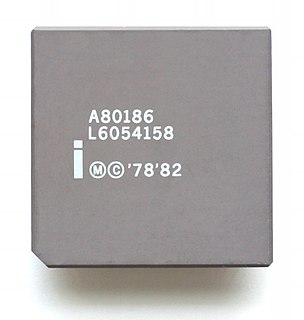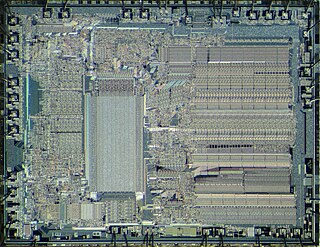
The Intel 80286 is a 16-bit microprocessor that was introduced on February 1, 1982. It was the first 8086-based CPU with separate, non-multiplexed address and data buses and also the first with memory management and wide protection abilities. The 80286 used approximately 134,000 transistors in its original nMOS (HMOS) incarnation and, just like the contemporary 80186, it could correctly execute most software written for the earlier Intel 8086 and 8088 processors.

The Intel 8080 ("eighty-eighty") is the second 8-bit microprocessor designed and manufactured by Intel. It first appeared in April 1974 and is an extended and enhanced variant of the earlier 8008 design, although without binary compatibility. The initial specified clock rate or frequency limit was 2 MHz, with common instructions using 4, 5, 7, 10, or 11 cycles. As a result, the processor is able to execute several hundred thousand instructions per second. Two faster variants, the 8080A-1 and 8080A-2, became available later with clock frequency limits of 3.125 MHz and 2.63 MHz respectively. The 8080 needs two support chips to function in most applications: the i8224 clock generator/driver and the i8228 bus controller. It is implemented in N-type metal-oxide-semiconductor logic (NMOS) using non-saturated enhancement mode transistors as loads thus demanding a +12 V and a −5 V voltage in addition to the main transistor–transistor logic (TTL) compatible +5 V.

The 8086 is a 16-bit microprocessor chip designed by Intel between early 1976 and June 8, 1978, when it was released. The Intel 8088, released July 1, 1979, is a slightly modified chip with an external 8-bit data bus, and is notable as the processor used in the original IBM PC design.

The Intel 8088 microprocessor is a variant of the Intel 8086. Introduced on June 1, 1979, the 8088 has an eight-bit external data bus instead of the 16-bit bus of the 8086. The 16-bit registers and the one megabyte address range are unchanged, however. In fact, according to the Intel documentation, the 8086 and 8088 have the same execution unit (EU)—only the bus interface unit (BIU) is different. The original IBM PC is based on the 8088, as are its clones.

The Intel 386, originally released as 80386 and later renamed i386, is a 32-bit microprocessor introduced in 1985. The first versions had 275,000 transistors and were the CPU of many workstations and high-end personal computers of the time. As the original implementation of the 32-bit extension of the 80286 architecture, the i386 instruction set, programming model, and binary encodings are still the common denominator for all 32-bit x86 processors, which is termed the i386-architecture, x86, or IA-32, depending on context.

The Intel 80186, also known as the iAPX 186, or just 186, is a microprocessor and microcontroller introduced in 1982. It was based on the Intel 8086 and, like it, had a 16-bit external data bus multiplexed with a 20-bit address bus. The 80188 variant, with an 8-bit external data bus was also available.

The Intel 8085 ("eighty-eighty-five") is an 8-bit microprocessor produced by Intel and introduced in March 1976. It is a software-binary compatible with the more-famous Intel 8080 with only two minor instructions added to support its added interrupt and serial input/output features. However, it requires less support circuitry, allowing simpler and less expensive microcomputer systems to be built.

The Am386 CPU is a 100%-compatible clone of the Intel 80386 design released by AMD in March 1991. It sold millions of units, positioning AMD as a legitimate competitor to Intel, rather than being merely a second source for x86 CPUs.

The Intel 8087, announced in 1980, was the first x87 floating-point coprocessor for the 8086 line of microprocessors.

The Intel 8259 is a Programmable Interrupt Controller (PIC) designed for the Intel 8085 and Intel 8086 microprocessors. The initial part was 8259, a later A suffix version was upward compatible and usable with the 8086 or 8088 processor. The 8259 combines multiple interrupt input sources into a single interrupt output to the host microprocessor, extending the interrupt levels available in a system beyond the one or two levels found on the processor chip. The 8259A was the interrupt controller for the ISA bus in the original IBM PC and IBM PC AT.

The Intel 8253 and 8254 are programmable interval timers (PITs), which perform timing and counting functions using three 16-bit counters.
The 386SLC was an Intel-licensed version of the 386SX, developed and manufactured by IBM in 1991. It included power-management capabilities and an 8KB internal CPU cache, which enabled it to yield comparable performance to 386DX processors of the same clock speed, which were considerably more expensive. Known inside IBM as "Super Little Chip" for its initials, it was used in the IBM PS/2 35, 40 and 56 Series and in the IBM PS/ValuePoint 325T, but never gained much market share. This was mainly due to an agreement with Intel, in which IBM was not allowed to sell their CPUs if they were not part of a system or upgrade board. It was also marketed as an optional upgrade for 8086-equipped IBM PS/2 25 Series computers.

The Intel 8255 Programmable Peripheral Interface (PPI) chip was developed and manufactured by Intel in the first half of the 1970s for the Intel 8080 microprocessor. The 8255 provides 24 parallel input/output lines with a variety of programmable operating modes.

Intel 8237 is a direct memory access (DMA) controller, a part of the MCS 85 microprocessor family. It enables data transfer between memory and the I/O with reduced load on the system's main processor by providing the memory with control signals and memory address information during the DMA transfer.

The Intel 8089 input/output coprocessor was available for use with the 8086/8088 central processor. It was announced on May 1979, but the price was not available at that time. It used the same programming technique as 8087 for input/output operations, such as transfer of data from memory to a peripheral device, and so reducing the load on the CPU. This I/O processor was available on July 1979 for US$194.20 in quantities of 100 or more. Intel second sourced this coprocessor to Fujitsu Limited.

The Intel 8282 is an 8-bit latch, which was developed primarily for the Intel-8086/8087/8088/8089-processors. The component comes in 20-pin DIL package. It was licensed to companies such as NEC and Siemens. With the ROM-less versions of the MCS-48 and MCS-51 microcontroller compact systems with external ROM / EPROM can be realized. The 8282 can also be used in 8080/8085-systems replacing the 8212. If OE is connected to GND, the chip is selected. STB (Strobe) is connected to the pin ALE of the processor and takes over the address data from the multiplexed address-/databus. The 8283 has the same functionality, but the data is inverted. In 1980 the Intel 8282 and I8282 version was available for 5.55 USD and 16.25 USD in quantities of 100 respectively.

The Intel 8283 is an 8-bit latch, which was developed primarily for the Intel-8086/8087/8088/8089-processors. The component comes in 20-pin DIL package. It was licensed i.e. to NEC and Siemens. If OE connected to GND, the chip is selected. STB (Strobe) is connected to the pin ALE of the processor and takes over the address data from the multiplexed address-/databus. The incoming data is inverted – as opposed to the 8282. The Intel 8283 and I8283 version was available for US$5.55 and $16.25 in quantities of 100 respectively.

The Intel 8288 is a bus controller designed for Intel 8086/8087/8088/8089. The chip is supplied in 20-pin DIP package. The 8086 operate in maximum mode, so they are configured primarily for multiprocessor operation or for working with coprocessors. Necessary control signals are generated by the 8288. It was used in the IBM PC, XT and its clones. IBM PC AT used its successor Intel 82288.
The Intel 8231 and 8232 were early designs of floating-point maths coprocessors (FPUs), marketed for use with their i8080 line of primary CPUs. They were licensed versions of AMD's Am9511 and Am9512 FPUs, from 1977 and 1979, themselves claimed by AMD as the world's first single-chip FPU solutions.
The NEC μCOM series is a series of microprocessors and microcontrollers manufactured by NEC in the 1970s and 1980s.


















